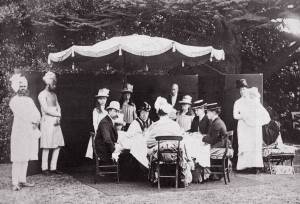An article published yesterday by James Hall, Consumer affairs expert for The Telegraph, claimed that ‘Builder’s tea’ (English breakfast tea) has lost some of it’s long standing popularity with the British population and young people are now turning to healthier alternatives like Green Tea!
As a Brit and a purist when it comes to tea drinking, I struggle to imagine in the future ‘Dave the Builder’, (with standard bum crack peaking from the top of his tool belt), . . downing his power tools, pulling up a bean bag, lighting some joss sticks and sipping on a cup of ‘Pi Lo Chun Green Tea’ (Green Snail Spring).
Perhaps the youth of today are turning to healthier alternatives but do they know how much tea has shaped the nation they live in today? Some historians would almost certainly agree with me that tea did indeed help to shape the World’s modern nations and put the once ‘Great‘ in Great Britain!
Our love for tea has existed since the 17th Century when Dutch and Portuguese traders began bringing it to the our shores. Thomas Garraway, a coffee house owner and merchant claimed in a pamphlet that tea made ‘the body active and lusty’. Soon the working class started turning to drinking tea, instead of gin in the public houses which the government levied taxes on. As a direct result, tea taxes rose to 119% and tea smuggling became commonplace. Smuggling gangs in the south coast of England were notorious for their violence until William Pitt Younger introduced the Commutation Act in 1784, which reduced the tax and so ended smuggling. The East India Company capitalised on the booming trade in tea in the mid 18th century, by creating a monopoly over all tea trade and drove the British Empire’s expansion in Asia. At it’s height the British Empire ruled about a third of the World’s people and half it’s wealth. For 5 generations, the sun never set on the Empire!
It is reasonable to argue that the demand for tea and other spices was one of the biggest factors in the British Empire expanding territories in Asia, in particular India. The colonisation of India meant 1.3 million Indian soldiers fought for Britain in the 1st World War and after the 2nd World War, labour shortages opened the way for mass immigration. People from all over the Empire entered Britain under British passports, allowing them the right to work and settle in the UK. In the 1940’s non white immigrants were in their low thousands, by the 1970’s there were 1.4 million.
Not only has tea influenced the history of the British Isles but also of our friends across the pond. My knowledge of American history is limited, but tea certainly had a hand in the start of the American civil war and ultimately the declaration of independence. The Boston Tea Party, I believe was the destruction of a cargo of tea in protest against the British Government and the British monopolisation of the tea trade with the American colonies and acted as a catalyst for the revolutionary movement against the British.
Tea as we know it in the UK today or ‘Builder’s tea‘ is an English colloquial term used to refer to strong tea normally drunk by construction workers on their break, however most Brits drink this type of tea and to an extent where it is an integral part of every day life. Tea break, Elevensies and Afternoon Tea are just some of the times in the day when we reach for the kettle, but it is certainly not limited to this.
A ‘Proper‘ cup of tea consists of:
- one good sized mug; probably a bit stained and chipped but it all adds to the flavour and overall experience
- one tea bag (Tetleys, PG Tips, Yorkshire Tea, Typhoo etc); other brands are ok but these are the best cheap ‘non fancy’ ones
- boiling water to pour over the tea bag; the key thing here is not to put the milk in first because it clogs up the bag and doesn’t allow the tea to stew
- patience; ‘Good things come to those who wait‘. Much like you wait for a pint of Guinness to settle before you fill it to the top, you should allow the tea bag to stew allowing the tea flavour to permeate the water,
- Milk; Some people like it milky but a builders tea is traditionally strong without much milk. Powdered milk substitutes, long life or cream just will not do!
- Sugar; if we are sticking to tradition, a hefty tea spoonful or two of sugar is best.
Finally you remove the tea bag by straining it against the side of the cup and throwing it in the bin without dripping tea all over the floor or burning your fingers, and stir. Enjoy with a biscuit of your choice, however, I recommend a Hob Nob for its optimal dunking properties. To quote Peter Kay (Comedian) ‘Hob Nobs are the Marines of the biscuits world’. This is due to the fact that a they absolutely refuse to disentegrate no matter how long you keep dunking them for. http://www.youtube.com/watch?v=xnC96tqyk5M
So next time you have a brew or a cup of char you should consider the impact that little cup of lovely-ness had on the world and pay respects to the drink that made Britain once Great!



